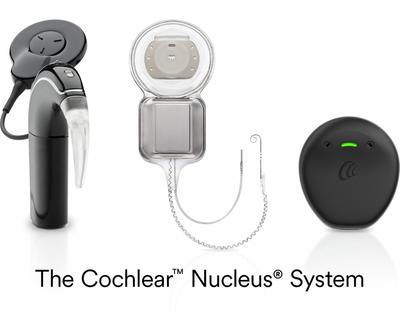FDA approves Cochlear Nucleus Implants for unilateral hearing loss/single-sided deafness
January 11, 2022
Media Contact
Renee Oehlerking
Cochlear Americas
303-264-2104
roehlerking@Cochlear.com
FDA approves Cochlear Nucleus Implants for unilateral hearing loss/single-sided deafness
Individuals with UHL/SSD can now seek treatment with a cochlear implant from Cochlear to hear with both ears
Lone Tree, Colo. (January 11, 2022) — Cochlear Limited (ASX: COH), the global leader in implantable hearing solutions, obtained U.S. Food and Drug Administration (FDA) approval of Cochlear™ Nucleus® Implants for the treatment of unilateral hearing loss (UHL)/single-sided deafness (SSD).
Cochlear implants are already FDA approved for those with moderate to profound bilateral sensorineural hearing loss. With this approval, for the first time Cochlear can expand implantable treatment options for those with UHL/SSD to include cochlear implants.
UHL is classified as hearing loss in one ear and near to near-normal hearing in the opposite ear, and SSD is specific to individuals with severe to profound hearing loss in one ear and normal or near-normal hearing in the other ear. Every year, about 60,000 people in the United States acquire SSD.1
“It is not often that approvals to expand indications and increase awareness about effective treatments for hearing loss come along. Now with this approval, Cochlear is proud to offer the most hearing implant options available to those with unilateral hearing loss/single-sided deafness through our cochlear implant and bone conduction solutions,” said Christine Menapace, MA, Vice President, Clinical Affairs, Cochlear Americas. “It is important that those with this type of hearing loss recognize the impact to their lives and understand there are several options available to them, and we encourage them to talk to their hearing health professional today to find out what would work best for them.”
UHL/SSD can impact an individual’s quality of life, including mental fatigue because of increased listening effort, as well as impacts to understanding speech in noise and localizing where sounds are coming from.2-6 Hearing with both ears is important. Hearing with two ears helps one to identify sounds both near and far, as well as those that occur 360 degrees around the head.7
“Unilateral sensorineural hearing loss has continued to gain greater acceptance in the field as an indication for cochlear implantation,” said Dr. Kevin Brown, Vice Chair, Chief of Neurotology and Executive Director of the Children’s Cochlear Implant Center at the University of North Carolina. “With this approval, it is important my industry colleagues and I ensure appropriate clinical guidance on how to effectively introduce this cochlear implant indication, outline a model for selecting patients that will benefit, and ensure success after implantation.”
Cochlear will now support those with UHL/SSD by offering its cochlear implant, the Cochlear Nucleus System, and bone conduction solutions, the Cochlear Osia® System and the Cochlear Baha® System. Cochlear’s implantable hearing solutions restore access to sound to improve quality of life and meet the lifestyle needs and preferences of each individual recipient.
About Cochlear Limited (ASX: COH)
People have always been Cochlear’s inspiration, ever since Professor Graeme Clark set out to create the first multi-channel cochlear implant after seeing his father struggle with hearing loss. Since 1981, Cochlear has provided more than 650,000 devices in more than 180 countries, helping people of all ages around the world to hear. As the global leader in implantable hearing solutions, Cochlear connects people with life’s opportunities, and welcomes them to the world’s largest hearing implant community.
Cochlear has a global workforce of more than 4,000 people, with a passion for progress, who strive to meet the needs of people living with hearing loss. The company continually innovates to anticipate future needs, investing more than AUD$2 billion to date in research and development to push the boundaries of technology and help more people hear.
###
References
- Weaver, J. "Single-Sided Deafness: Causes, and Solutions, Take Many Forms." Hearing Journal 68.3 (2015): 20-24. Web. 28 Apr. 2017. http://journals.lww.com/thehearingjournal/Fulltext/2015/03000/Single_Sided_Deafness___Causes,_and_Solutions,.1.aspx
- Buss E, Dillon MT, Rooth MA et al. Effects of Cochlear Implantation on Binaural Hearing in Adults With Unilateral Hearing Loss. Trends Hear 2018; 22:2331216518771173.
- Firszt JB, Reeder RM, Holden LK, Dwyer NY, Asymmetric Hearing Study T. Results in Adult Cochlear Implant Recipients With Varied Asymmetric Hearing: A Prospective Longitudinal Study of Speech Recognition, Localization, and Participant Report. Ear Hear 2018; 39:845-862.
- Tavora-Vieira D, Rajan GP, Van de Heyning P, Mertens G. Evaluating the Long-Term Hearing Outcomes of Cochlear Implant Users With Single-Sided Deafness. Otol Neurotol 2019; 40:e575-e580.
- Dillon MT, Buss E, Anderson MLet al. Cochlear Implantation in Cases of Unilateral Hearing Loss: Initial Localization Abilities. Ear Hear 2017; 38:611-619.
- Dillon MT, Buss E, Rooth MA et al. Effect of Cochlear Implantation on Quality of Life in Adults with Unilateral Hearing Loss. Audiol Neurootol 2017; 22:259-271.
- Wazen JJ, Spitzer JB, Ghossaini SN, Fayad JN, Niparko JK, Cox K, et al. Transcranial contralateral cochlear stimulation in unilateral deafness. Otolaryngology-Head & Neck Surgery 2003;129(3):248-54.
Please seek advice from your health professional about treatments for hearing loss. Outcomes may vary, and your health professional will advise you about the factors which could affect your outcome. Always read the instructions for use. Not all products are available in all countries. Please contact your local Cochlear representative for product information.
© Cochlear Limited 2022. All rights reserved.



